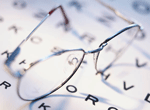As a long-time wearer of glasses for both reading and normal vision, I am always on the lookout for a really comfortable and useful pair of glasses. I own several different pairs of glasses: one for reading, one for sports/outdoor activities, and a pair of bifocals when I need to be able to both read and be active. I used to own a pair of glasses with progressive lens, but I found they progressively gave me headaches.
So I was intrigued when I saw a story last month in the LA Times last month about a new pair of glasses on the market trademarked under the name emPower which are made by PixelOptics in Roanoke, Virginia. According to the article, the company’s eye glasses “... combine traditional lenses with transparent liquid crystals. A microprocessor makes the liquid crystals change the glasses’ prescription, either automatically or on command, when activated by a tiny accelerometer [say by tilting your head] or a finger touching a sensor on the earpiece.”
You can get a full description of how they work at the company’s web site here. The current cost, the Times says, is around $1250 (which is expected to drop over time) and the microprocessor battery once charged lasts two or three days. There isn’t a sunglasses/tinting option yet, although the company reportedly is working on it. You also have to treat the glasses as you would a cell phone: no cleaning the lenses by running them under the faucet.
There was also a related story in today’s London Daily Mail about the latest work being done by Professor Babak Parviz at the University of Washington in Seattle on developing contact lens that will be able to display information that can be read by their wearer. Dr. Parviz envisions a day when you will be able to receive your news, tweets, etc. directly via your contact lenses. Dr. Parviz wrote a feature story in 2009 for IEEE Spectrum on augmented reality via contact lenses that you can read here.
The story also says that Professor Parviz is “... investigating the idea of incorporating sensors that will pick up blood sugar levels and other potentially important medical information.” You can a Spectrum post from last year on diagnostic contacts for tracking ocular pressure here.
In addition, the Daily Mail story also mentions that a number of patients in the UK suffering from hereditary retinal degeneration will soon be fitted with the latest experimental retinal microchip developed by the German firm Retina Implant in the back of their eyes that contains some 1,500 light sensors. “The sensors convert light to electrical signals. These stimulate nerves in the retina which pass signals down the optic nerve to the brain to turn into an image,” the Daily Mail says.
If the operations prove safe and effective in the UK and in other parts of Europe, the hope is the electronic prosthesis will be approved for wide-spread use by 2013. The first experiments with these chips were conducted in 2005. You can read more about the technology being used here [PDF].
Finally, there was a story earlier this week in the Wall Street Journal about how glasses—without lenses—that was a fashion craze in Japan in the 1990s has returned “with a vengeance among urbanites, male and female, in China, South Korea and Taiwan.” Paradoxically, a very high proportion of people in their 20’s in these countries—estimated to be as high as 85% in Hong Kong, for example—actually suffer from myopia and need glasses.
Go figure.
Robert N. Charette is a Contributing Editor to IEEE Spectrum and an acknowledged international authority on information technology and systems risk management. A self-described “risk ecologist,” he is interested in the intersections of business, political, technological, and societal risks. Charette is an award-winning author of multiple books and numerous articles on the subjects of risk management, project and program management, innovation, and entrepreneurship. A Life Senior Member of the IEEE, Charette was a recipient of the IEEE Computer Society’s Golden Core Award in 2008.



